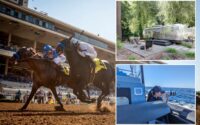Why even non-diver should visit the Carib island of Bonaire
It’s the hardest TikTok challenge yet: Enjoy the fabled Caribbean isle of Bonaire without snorkeling, diving, fill-in-the-blank-boarding or any other watersport that involves injury/death liability waivers.
Don’t bother seeking help in that dusty old Fodor’s tome of yours or even the dentist office’s travel glossy from last month. They’ll offer little more than infinitely regurgitated dive site maps and beach reviews (if we have to hear about the 1000 Steps one more time, I swear to God…).
Bonaire is a proper desert — complete with cacti, donkeys, desalination plants, et. al — and should be respected as such.
And there’s nothing more disrespectful to a desert than focusing on its water, of all things.
Here’s how to have a merry time, hold the maritime, on the Caribbean’s PADI scuba school alum-swarmed oasis that’s — trigger warning — best experienced above sea level.

Spiked cactus
Let it be known: The B of the Spanish-then-Dutch-settled ABC islands (dyslexic to the end, it’s technically [A]ruba, [C]uracao, [B]onaire on maps) is the only Caribbean island that produces whiskey. It’s also home to the International Wine and Spirit Competition’s gold medal winner for rum and coke. And it’s the first place in the world ever to churn out vodka made from cacti.
‘Cause let’s face it: #BonaireBeLush.
These fun facts are all thanks to the 16,000-square-foot distillery Cadushy (pronounced the funny way), located smack dab in the center of early-to-bed Rincon, one of only two proper towns on the thirsty island.
Slaking islanders’ and Dutch royals’ liquid longings since 2009, Cadushy is named for the kind of cactus from which its battery of booze is made. That includes rum, whiskey, gin, vodka and all sorts of naturally taste-the-rainbow liqueurs inspired by, and flavored for, each member of the Dutch Caribbean, sans Sint Maarten, with the motherland of Holland in its place. Try their wares at their outdoor bar, open only during the day.
After-hours drinkers should head to the sexy new Polynesian-themed Tiki & Co. on Kaya Bonaire in Kralendijk, the capital city. It’s chock full of the sort of skulls, god statues and other spooky Pacific island paraphernalia you’d find inside a Trader Vic’s. For moonlighting mixologists, they host cocktail contests, with one even landing a winner a trip to the Netherlands.
Different strokes

Meditate on this: If every golf shot lands in the sand, don’t sandtraps cease to be? That logic alone should lure any not-so-scratch golfer to Bonaire’s funky Piedra So golf club which sports “browns” (natural soil) instead of artificially grown greens like you’re used to (at least on the back nine).
In fact, most of the natural green spots you’ll find here scenically surround the course — avoid chasing after your Titleists in them and just take a mulligan because they’re likely filled with cacti or other spiny plants. Green fees from $25; lessons at its school from $55.
Become an eco maniac

There’s about as much anti-unmanned-aerial-vehicle sentiment on Bonaire as in Afghanistan — you’ll find official “no drones allowed” signage everywhere. That’s because here, drones too are killers, particularly of protected coral when, however inadvertently, dunked into the sea. So keep your cameras ground-level and on your person when ’Gramming the sexy scenery. Fines, even a trip to the pokey, are just a few of the ways they deal with visitors who go rogue (our tour guide dropped the dime on one such violator in Washington Slagbaai National Park via cell phone — popo was on him within minutes).

Better yet, help out and volunteer while on the island, you’ll still get a tan. There’s Coral Reef Restoration; the parrot-focused Echo (get it?); Sea Turtle Conservation; Wild Bird Rehab; and Debris Free Bonaire, to name a few.
Think outside the flocks

If you have both the binoculars and the moxie — let’s call it “binoxie,” just to make haters hate — here’s a hot take: There’s more to this part of the world than its flamboyances of flamingos (but they remain the island’s undisputed champions, bow down). Birding is alive and well on this little island and there are plenty of other sought-after featherati to keep an eye out for like the Caribbean parakeet and the yellow-shouldered parrot, exclusively found on Bonaire, just two of over 200 avian species here.
Bonaire Bird Photography Tours’ Susan Davis will take you through Bonaire’s south (a Western Hemisphere Shorebird Reserve Network site, one of only two in the Caribbean), north and/or interior, depending on what you’d like check off your list.
Gust of honor

After salt, Bonaire’s most worshipped natural resource is likely its wind, best harnessed at Bonaire Landsailing Adventures, where it’s used to power motorless, sail-equipped, single-rider “blokarts” around a figure-eight track.
Full disclosure: You do have to sign a waiver (the karts will hit speeds of 20 to 25 mph on an obedient windy day, 40 mph if it’s storming, and they can get temporarily airborne for a hot second). But it’s, as one travel companion put it, about as death-defying as a game of Mario Kart so long as you keep your hands inside — both a mom and her two young boys likewise buckled in.
And yes, of course this wacky sport was brought to the island by New Zealanders: the lovely and amiable Donna Hudgeon and her hubby Andrew Sands. From $50/hour.
Tag, you’re it

They may not have traffic lights on Bonaire but they do have more endearing reminders of metropolitan life: food trucks and awesome graffiti. Why not combine the two? Pick up a wrap or tuna burger at one of the many food trucks lining the coast of Kralendijk, like Kite City or Cactus Blue, and go hunting for Bonaire’s fabulously painted walls.
Street Colors Bonaire couples professional Dutch and island-born street artists with local kids to help beautify the island. Holding various events and tours, in COVID times YMMV, they’re behind several famous Bonairean masterpieces at heavily trafficked places like the Crossfit Flamingo Gym and the skatepark at Jong Bonaire.
On the up and up

Bonaire’s flat, 111-square-mile landscape is truly extraterrestrial: beaches, gardens of cacti, windmills, salt pyramids, lighthouses, obelisks and slave huts dating back to its problematic salt trade days, parked cruise ships and KLM jumbo jets that dwarf every building in sight.
But to take it all in, you’ll want to visit Brandaris, Bonaire’s highest peak at 784 feet, rising out of its northern tip. And while hiking is diving’s diametric opposite, it’s not illegal here — a relatively mild, 45-minute trail awaits.

LOWDOWN
Fly: Sample October fare was $626/RT with a connection in Miami (don’t pout) on American.

Stay: The very yellow Harbour Village Beach Club is a literally named mini gated community on the beach with spacious kitchenette-included rooms and villas and a fun, open-air restaurant/bar which would be perfect if only it came with a bathroom. A boy can dream (from $295). For a slightly livelier, casino-included experience (one of only two on the island), there’s the Divi Flamingo Resort sitting on a historic site that was once a POW camp for sneaky tropical Nazis the locals caught during World War II. Facts (from $175).
Dine: There’s going to be major peer pressure on you to eat as locals do, which here usually means fish or something soused in mayo. But since you’re already in contrarian mode, you can resist and order up a pizzetta at Ingridiënts at the Buddy Dive Resort on Kaya Gob. N. Debrot. The crispy, salamied Piccante pie slaps.
The author was a guest of Tourism Corporation Bonaire.




